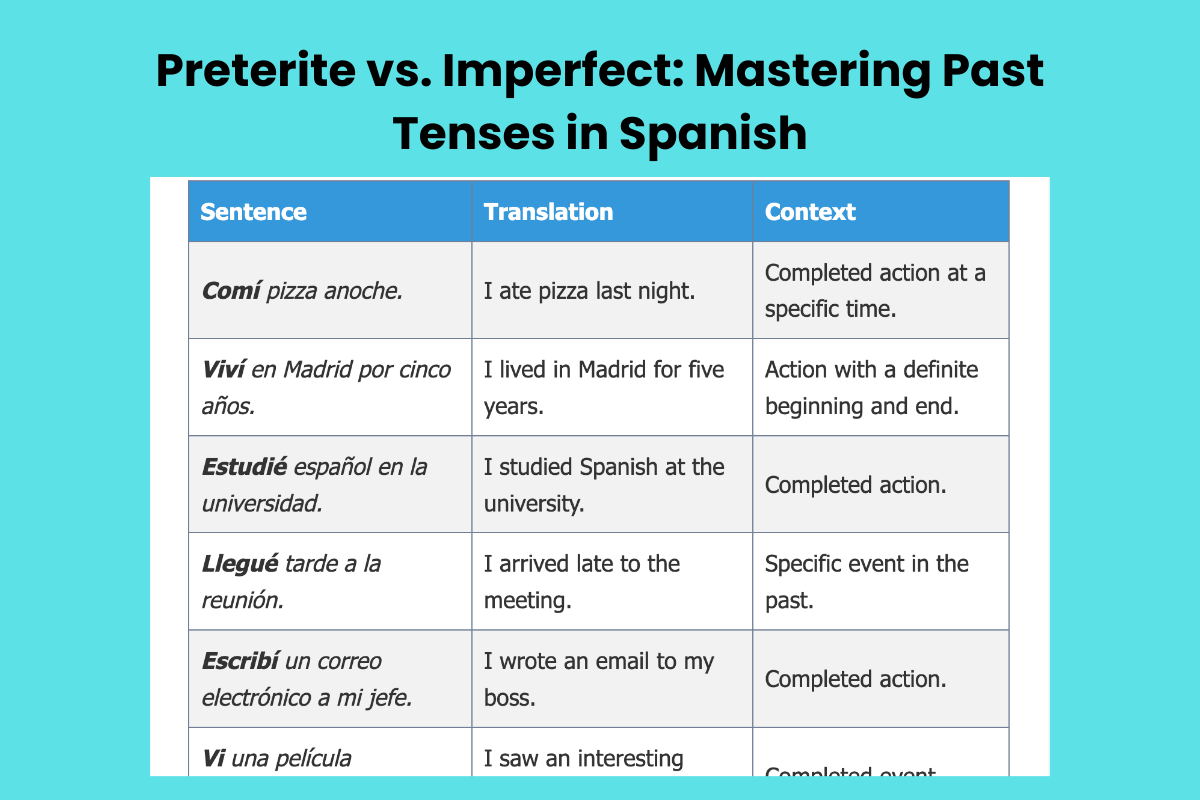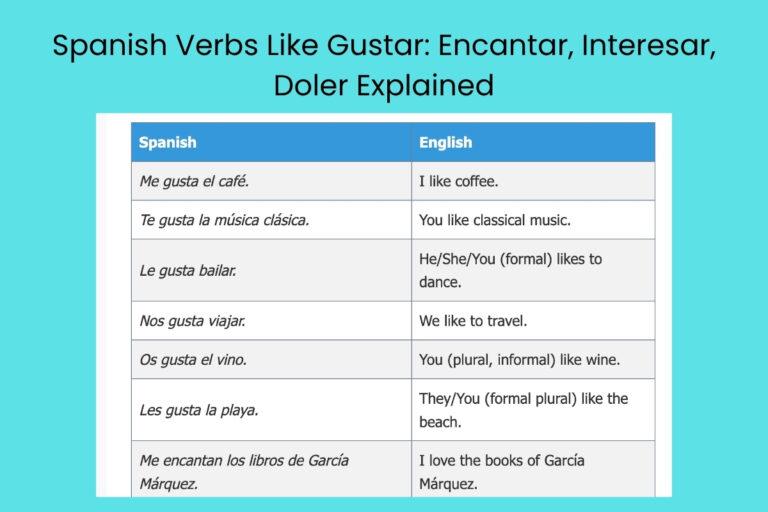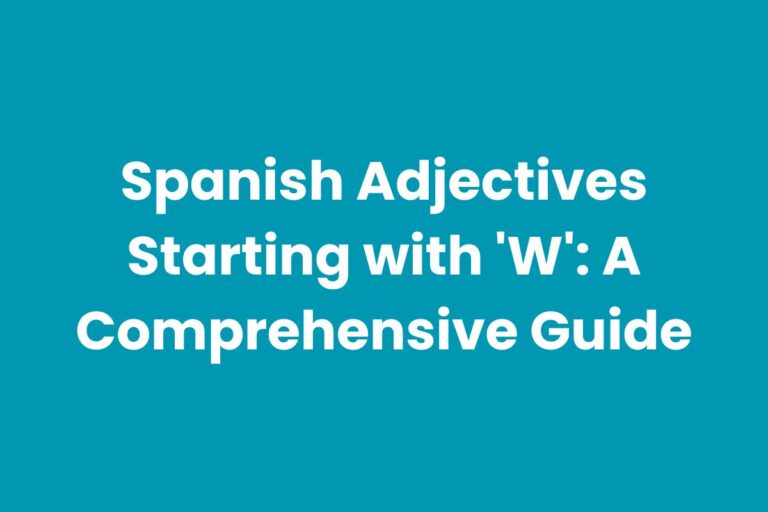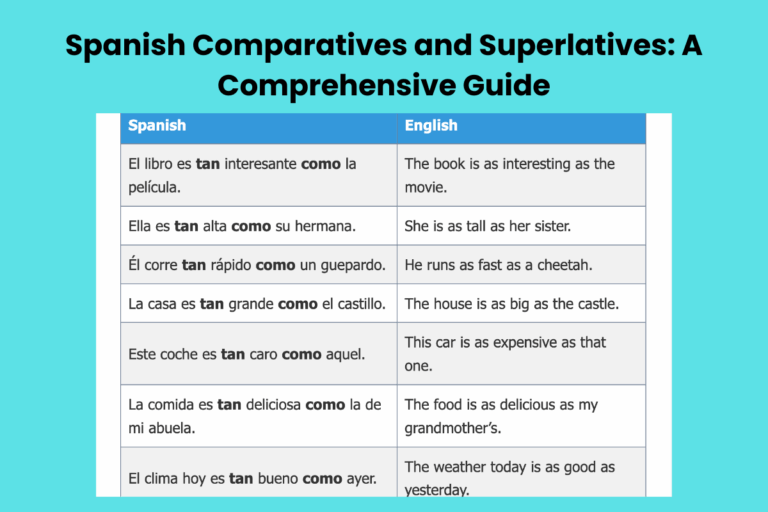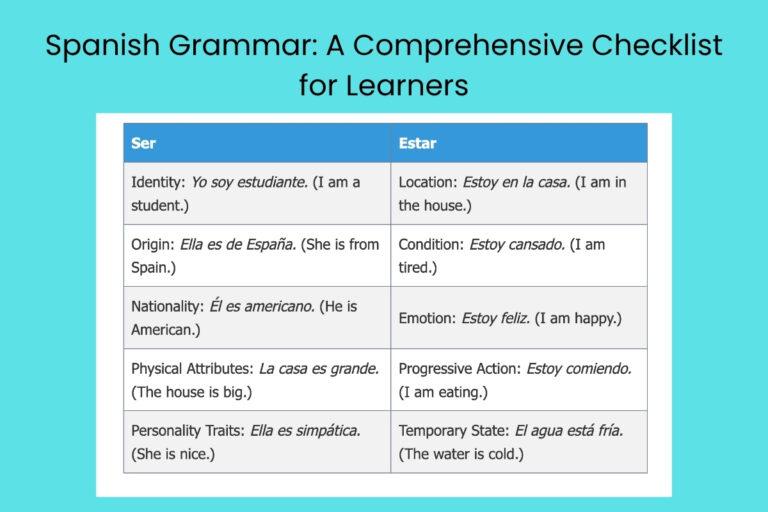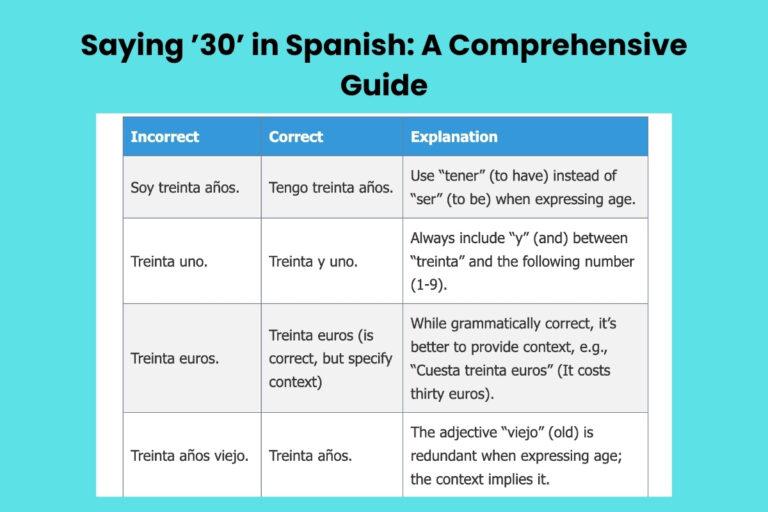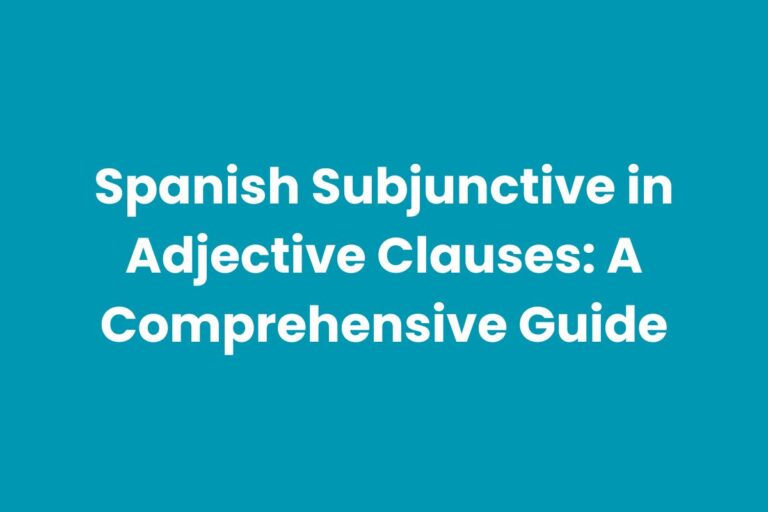Preterite vs. Imperfect: Mastering Past Tenses in Spanish
Navigating the past tenses in Spanish can be tricky, especially when deciding between the preterite and imperfect. These two tenses describe different aspects of the past, and choosing the correct one is crucial for clear and accurate communication.
Understanding the nuances of the preterite and imperfect tenses is essential for anyone learning Spanish, from beginners to advanced speakers. This guide provides a comprehensive overview of these tenses, their uses, and how to distinguish between them, ensuring you can confidently express yourself in the past.
Definitions: Preterite and Imperfect
Preterite Definition
The preterite tense (also known as the pretérito indefinido or pretérito perfecto simple) in Spanish is used to describe actions that were completed at a specific point in the past. It focuses on the beginning and end of an action, presenting it as a finished event. The preterite is often used for single, completed actions, a series of completed actions, or actions that occurred over a defined period of time. Think of it as the tense that tells you “what happened.”
Essentially, the preterite is used to narrate events that had a clear starting and ending point. It signifies a break from the present, emphasizing that the action is entirely in the past and has no continuing relevance to the present moment. Key words often associated with the preterite include ayer (yesterday), anoche (last night), la semana pasada (last week), el año pasado (last year), and specific dates or times.
Imperfect Definition
The imperfect tense (also known as the pretérito imperfecto) in Spanish is used to describe ongoing or habitual actions in the past. Unlike the preterite, the imperfect does not focus on the completion of the action. Instead, it emphasizes the duration, repetition, or characteristics of a past action or state. It’s often used to describe what “was happening” or “used to happen.”
The imperfect tense provides background information, sets the scene, and describes conditions or states of being in the past. It’s used for habitual actions, descriptions, and actions that were in progress when something else interrupted them. Key words often associated with the imperfect include siempre (always), a menudo (often), cada día (every day), mientras (while), and cuando era niño/a (when I was a child).
Structural Breakdown
Preterite Conjugation
To use the preterite tense correctly, you need to understand how to conjugate regular and irregular verbs. Regular verbs follow predictable patterns, while irregular verbs have unique conjugations that must be memorized. Here’s a breakdown of the regular preterite conjugations for -ar, -er, and -ir verbs:
Regular Verbs:
| Pronoun | -AR Verbs (e.g., hablar – to speak) | -ER Verbs (e.g., comer – to eat) | -IR Verbs (e.g., vivir – to live) |
|---|---|---|---|
| Yo | hablé | comí | viví |
| Tú | hablaste | comiste | viviste |
| Él/Ella/Usted | habló | comió | vivió |
| Nosotros/Nosotras | hablamos | comimos | vivimos |
| Vosotros/Vosotras | hablasteis | comisteis | vivisteis |
| Ellos/Ellas/Ustedes | hablaron | comieron | vivieron |
Irregular Verbs:
Many common verbs have irregular preterite conjugations. Some of the most important irregular verbs include ser/ir (to be/to go), estar (to be), tener (to have), hacer (to do/make), poder (to be able to), poner (to put), saber (to know), querer (to want), venir (to come), and decir (to say). These verbs often have stem changes or completely different endings. For example, the preterite of ser/ir is the same: fui, fuiste, fue, fuimos, fuisteis, fueron.
Imperfect Conjugation
The imperfect tense has simpler conjugation patterns than the preterite, with fewer irregular verbs. Here’s a breakdown of the regular imperfect conjugations for -ar, -er, and -ir verbs:
Regular Verbs:
| Pronoun | -AR Verbs (e.g., hablar – to speak) | -ER Verbs (e.g., comer – to eat) | -IR Verbs (e.g., vivir – to live) |
|---|---|---|---|
| Yo | hablaba | comía | vivía |
| Tú | hablabas | comías | vivías |
| Él/Ella/Usted | hablaba | comía | vivía |
| Nosotros/Nosotras | hablábamos | comíamos | vivíamos |
| Vosotros/Vosotras | hablabais | comíais | vivíais |
| Ellos/Ellas/Ustedes | hablaban | comían | vivían |
Irregular Verbs:
There are only three irregular verbs in the imperfect tense: ser (to be), ir (to go), and ver (to see). Their conjugations are as follows:
- Ser: era, eras, era, éramos, erais, eran
- Ir: iba, ibas, iba, íbamos, ibais, iban
- Ver: veía, veías, veía, veíamos, veíais, veían
Types and Categories of Usage
Preterite Uses
The preterite tense is used for actions that:
- Are completed at a specific time: Ayer fui al cine. (Yesterday, I went to the cinema.)
- Have a definite beginning and end: Viví en España por dos años. (I lived in Spain for two years.)
- Are part of a sequence of events: Primero me desperté, luego me vestí, y después desayuné. (First, I woke up, then I got dressed, and then I had breakfast.)
- Express a change in state: De repente, empezó a llover. (Suddenly, it started to rain.)
- Narrate specific events in the past: El año pasado viajé a Italia. (Last year, I traveled to Italy.)
Imperfect Uses
The imperfect tense is used for actions that:
- Describe ongoing actions in the past: Estaba lloviendo cuando salí de casa. (It was raining when I left home.)
- Describe habitual actions in the past: Íbamos al parque todos los domingos. (We used to go to the park every Sunday.)
- Describe characteristics or conditions in the past: Era un niño muy tímido. (I was a very shy child.)
- Set the scene or provide background information: El sol brillaba y los pájaros cantaban. (The sun was shining and the birds were singing.)
- Express what someone was doing when something else happened: Estaba cocinando cuando sonó el teléfono. (I was cooking when the phone rang.)
- Express age in the past: Tenía diez años cuando aprendí a nadar. (I was ten years old when I learned to swim.)
- Express time in the past: Eran las tres de la tarde. (It was three in the afternoon.)
Examples
Preterite Examples
The following table provides examples of the preterite tense in different contexts. Notice how each example describes a completed action or event in the past.
| Sentence | Translation | Context |
|---|---|---|
| Comí pizza anoche. | I ate pizza last night. | Completed action at a specific time. |
| Viví en Madrid por cinco años. | I lived in Madrid for five years. | Action with a definite beginning and end. |
| Estudié español en la universidad. | I studied Spanish at the university. | Completed action. |
| Llegué tarde a la reunión. | I arrived late to the meeting. | Specific event in the past. |
| Escribí un correo electrónico a mi jefe. | I wrote an email to my boss. | Completed action. |
| Vi una película interesante ayer. | I saw an interesting movie yesterday. | Completed event. |
| Abrí la puerta y entré. | I opened the door and entered. | Sequence of completed actions. |
| Tomé un café esta mañana. | I had a coffee this morning. | Completed action. |
| Viajé a México el año pasado. | I traveled to Mexico last year. | Specific event in the past. |
| Leí un libro muy bueno. | I read a very good book. | Completed action. |
| Hablé con mi madre por teléfono. | I spoke with my mother on the phone. | Completed action. |
| Aprendí a nadar cuando tenía seis años. | I learned to swim when I was six years old. | Specific event in the past. |
| Compré un coche nuevo. | I bought a new car. | Completed action. |
| Recibí un regalo de mi amigo. | I received a gift from my friend. | Completed event. |
| Terminé mi trabajo a las cinco. | I finished my work at five o’clock. | Completed action at a specific time. |
| Salí de casa temprano. | I left home early. | Specific event in the past. |
| Bebí agua después de correr. | I drank water after running. | Completed action. |
| Caminé por el parque. | I walked through the park. | Completed action. |
| Cené en un restaurante elegante. | I dined at an elegant restaurant. | Completed action. |
| Escribí una carta a mi abuela. | I wrote a letter to my grandmother. | Completed action. |
| Perdí mi llave ayer. | I lost my key yesterday. | Completed action. |
| Entendí la lección perfectamente. | I understood the lesson perfectly. | Completed action. |
| Asistí a un concierto increíble. | I attended an incredible concert. | Completed action. |
Imperfect Examples
The following table provides examples of the imperfect tense. Notice how each example describes an ongoing action, a habitual action, or a state of being in the past.
| Sentence | Translation | Context |
|---|---|---|
| Estaba lloviendo cuando llegué. | It was raining when I arrived. | Ongoing action in the past. |
| Íbamos a la playa todos los veranos. | We used to go to the beach every summer. | Habitual action in the past. |
| Era muy feliz en mi infancia. | I was very happy in my childhood. | State of being in the past. |
| Trabajaba en una oficina pequeña. | I used to work in a small office. | Habitual action in the past. |
| Siempre leía antes de dormir. | I always used to read before sleeping. | Habitual action in the past. |
| Tenía diez años cuando me mudé. | I was ten years old when I moved. | Describing age in the past. |
| Hacía frío esa noche. | It was cold that night. | Describing conditions in the past. |
| Vivía cerca del parque. | I used to live near the park. | Describing location in the past. |
| Comía mucha fruta cuando era niño. | I used to eat a lot of fruit when I was a child. | Habitual action in the past. |
| Veía la televisión todos los días. | I used to watch television every day. | Habitual action in the past. |
| Estudiaba mucho para los exámenes. | I used to study a lot for the exams. | Habitual action in the past. |
| Tocaba el piano cuando era joven. | I used to play the piano when I was young. | Habitual action in the past. |
| Bebía café por la mañana. | I used to drink coffee in the morning. | Habitual action in the past. |
| Caminaba al trabajo todos los días. | I used to walk to work every day. | Habitual action in the past. |
| Siempre llevaba un sombrero. | I always used to wear a hat. | Habitual action in the past. |
| Visitaba a mi abuela cada semana. | I used to visit my grandmother every week. | Habitual action in the past. |
| Escuchaba música en la radio. | I used to listen to music on the radio. | Habitual action in the past. |
| Jugaba al fútbol con mis amigos. | I used to play soccer with my friends. | Habitual action in the past. |
| Nadaba en la piscina cada tarde. | I used to swim in the pool every afternoon. | Habitual action in the past. |
| Escribía en mi diario cada noche. | I used to write in my diary every night. | Habitual action in the past. |
| Conducía un coche viejo. | I used to drive an old car. | Describing a state in the past. |
| Había mucha gente en la fiesta. | There were many people at the party. | Describing a condition in the past. |
| Creía en fantasmas cuando era niño. | I believed in ghosts when I was a child. | Describing a belief in the past. |
The following table highlights the key differences between preterite and imperfect tenses, offering scenarios and examples to illustrate their distinct usages.
| Feature | Preterite | Imperfect |
|---|---|---|
| Focus | Completed actions, specific events | Ongoing actions, habitual actions, descriptions |
| Time Frame | Definite beginning and end | No specific beginning or end |
| Usage | To narrate events, tell stories | To describe scenes, provide background |
| Key Words | Ayer, anoche, la semana pasada | Siempre, a menudo, cada día, mientras |
| Example | Fui al cine ayer. (I went to the cinema yesterday.) | Íbamos al cine todos los domingos. (We used to go to the cinema every Sunday.) |
| Another Example | Comí pizza anoche. (I ate pizza last night.) | Comía pizza a menudo. (I used to eat pizza often.) |
| Yet Another Example | Estudié español el año pasado. (I studied Spanish last year.) | Estudiaba español en la universidad. (I used to study Spanish at the university.) |
Usage Rules
Preterite Rules
Use the preterite tense when:
- Describing a single, completed action: Llamé a mi amigo ayer. (I called my friend yesterday.)
- Describing the beginning or end of an action: La película empezó a las ocho. (The movie started at eight o’clock.)
- Describing a series of completed actions: Me levanté, me vestí, y salí. (I got up, got dressed, and left.)
- Describing an action that interrupted another: While the imperfect tense usually provides the background action, the preterite can describe the interrupting action. Estaba comiendo cuando llegó mi hermano. (I was eating when my brother arrived.)
Imperfect Rules
Use the imperfect tense when:
- Describing an ongoing action without a specific end: Estaba lloviendo. (It was raining.)
- Describing habitual actions or routines: Íbamos a la escuela juntos. (We used to go to school together.)
- Describing physical or emotional states: Tenía miedo de la oscuridad. (I was afraid of the dark.)
- Setting the scene or providing background information: El cielo era azul y el sol brillaba. (The sky was blue and the sun was shining.)
- Expressing time or age in the past: Eran las cinco de la tarde. (It was five in the afternoon.) Tenía quince años. (I was fifteen years old.)
- Describing what someone was doing when something else happened: Estaba leyendo cuando sonó el teléfono. (I was reading when the phone rang.)
Common Mistakes
One of the most common mistakes is using the preterite to describe habitual actions or states of being in the past. For example:
- Incorrect: Yo fui a la playa todos los veranos. (I went to the beach every summer.)
- Correct: Yo iba a la playa todos los veranos. (I used to go to the beach every summer.)
Another common mistake is using the imperfect to describe single, completed actions. For example:
- Incorrect: Ayer estaba en el cine. (Yesterday, I was at the cinema.)
- Correct: Ayer estuve en el cine. (Yesterday, I was at the cinema.)
Here is a table with more examples of common mistakes and their corrections:
| Incorrect | Correct | Explanation |
|---|---|---|
| Yo comí pizza siempre. | Yo comía pizza siempre. | Habitual action requires the imperfect. |
| Ayer era muy feliz. | Ayer fui muy feliz. | Specific instance of happiness requires the preterite (although it is more common to use “estuve” to express a temporary state). |
| Estudiaba español ayer. | Estudié español ayer. | Completed action requires the preterite. |
| Cuando tenía cinco años, fui a Disney World cada año. | Cuando tenía cinco años, iba a Disney World cada año. | Habitual action in the past requires the imperfect. |
| Estaba a mi amigo ayer. | Llamé a mi amigo ayer. | Specific, completed action requires the preterite. “Llamar” is to call (on the phone). “Estar” is to be. |
Practice Exercises
Exercise 1: Preterite or Imperfect?
Choose the correct tense (preterite or imperfect) for each sentence.
| Question | Answer Choices | Correct Answer |
|---|---|---|
| 1. Yo _____ (ir) al parque todos los días cuando era niño. | a) fui b) iba | b) iba |
| 2. Ayer _____ (comer) pizza en un restaurante nuevo. | a) comí b) comía | a) comí |
| 3. Ella _____ (estudiar) español en la universidad el año pasado. | a) estudió b) estudiaba | a) estudió |
| 4. Nosotros _____ (ver) una película interesante anoche. | a) vimos b) veíamos | a) vimos |
| 5. Tú _____ (ser) muy simpático cuando te conocí. | a) fuiste b) eras | b) eras |
| 6. Ellos _____ (trabajar) en una oficina grande antes. | a) trabajaron b) trabajaban | b) trabajaban |
| 7. Yo _____ (tener) diez años cuando aprendí a montar en bicicleta. | a) tuve b) tenía | b) tenía |
| 8. Él _____ (llegar) tarde a la clase ayer. | a) llegó b) llegaba | a) llegó |
| 9. Nosotros _____ (vivir) en España por dos años. | a) vivimos b) vivíamos | a) vivimos |
| 10. Ella _____ (escribir) un libro cuando era joven. | a) escribió b) escribía | b) escribía |
Exercise 2: Fill in the Blanks
Fill in the blanks with the correct form (preterite or imperfect) of the verb in parentheses.
| Question | Answer |
|---|---|
| 1. Yo _____ (leer) un libro interesante ayer. | leí |
| 2. Ella _____ (cantar) en el coro todos los domingos. | cantaba |
| 3. Nosotros _____ (comer) en ese restaurante la semana pasada. | comimos |
| 4. Tú _____ (estudiar) mucho para el examen. | estudiabas |
| 5. Él _____ (llegar) a casa a las seis anoche. | llegó |
| 6. Ellos _____ (vivir) en París cuando eran jóvenes. | vivían |
| 7. Yo _____ (tener) mucho sueño esta mañana. | tenía |
| 8. Ella _____ (escribir) una carta a su abuela ayer. | escribió |
| 9. Nosotros _____ (ir) al cine cada mes. | íbamos |
| 10. Tú _____ (ser) muy amable conmigo. | eras |
Advanced Topics
Nuances with Specific Verbs
Some verbs change meaning depending on whether they are used in the preterite or imperfect. Understanding these nuances is crucial for advanced learners.
For example:
- Saber: In the preterite (supe), it means “found out” or “learned.” In the imperfect (sabía), it means “knew.”
- Conocer: In the preterite (conocí), it means “met” or “became acquainted with.” In the imperfect (conocía), it means “knew” (was acquainted with).
- Querer: In the preterite (quise), it means “tried” (and may or may not have succeeded). In the imperfect (quería), it means “wanted.”
- Poder: In the preterite (pude), it means “managed to” or “succeeded in.” In the imperfect (podía), it means “was able to” or “could.”
- Tener que: In the preterite (tuve que), it means “had to” and did do something. In the imperfect (tenía que), it means “had to” (but doesn’t specify if it was done).
Here’s a table illustrating these changes in meaning:
| Verb | Preterite Meaning | Imperfect Meaning | Example (Preterite) | Example (Imperfect) |
|---|---|---|---|---|
| Saber | Found out, learned | Knew | Supe la verdad ayer. (I found out the truth yesterday.) | Sabía la respuesta. (I knew the answer.) |
| Conocer | Met, became acquainted with | Knew (was acquainted with) | Conocí a Juan en la fiesta. (I met Juan at the party.) | Conocía a Juan desde niño. (I knew Juan since childhood.) |
| Querer | Tried (and may or may not have succeeded) | Wanted | Quise abrir la puerta, pero no pude. (I tried to open the door, but I couldn’t.) | Quería ir al cine. (I wanted to go to the cinema.) |
| Poder | Managed to, succeeded in | Was able | ||
| Tener que | Had to (and did do something) | Had to (but doesn’t specify if it was done) | Tuve que estudiar anoche. (I had to study last night.) | Tenía que estudiar, pero no lo hice. (I had to study, but I didn’t.) |
Combining Preterite and Imperfect in Narratives
The preterite and imperfect tenses are often used together in narratives to provide context and tell a story effectively. The imperfect sets the scene, describes ongoing actions, or provides background information, while the preterite describes specific events that occurred within that context.
This combination allows for a richer and more detailed narrative.
For example:
In this example, the imperfect tense (era, estaba leyendo) sets the scene and describes an ongoing action (reading), while the preterite tense (oí, me levanté, fui) describes specific events that occurred within that context (hearing a noise, getting up, and going to the window).
Here’s another example:
In this example, the imperfect tense (era, vivía, iba, jugaba) describes habitual actions and states of being in the past, while the preterite tense (decidí) describes a specific event that interrupted the routine.
FAQ
How do I know when to use the preterite vs. the imperfect?
Think of the preterite as describing completed actions with a clear beginning and end, while the imperfect describes ongoing or habitual actions, states of being, or background information. Ask yourself: Is this a single, completed event, or is it a description of something that was happening or used to happen?
Are there any words that always indicate the use of preterite or imperfect?
While not always definitive, certain words often suggest one tense over the other. Words like ayer (yesterday), anoche (last night), and specific dates often indicate the preterite. Words like siempre (always), a menudo (often), cada día (every day), and mientras (while) often indicate the imperfect.
What are the most common irregular verbs in the preterite and imperfect tenses?
Common irregular verbs in the preterite include ser/ir (to be/to go), estar (to be), tener (to have), hacer (to do/make), poder (to be able to), poner (to put), saber (to know), querer (to want), venir (to come), and decir (to say). In the imperfect, there are only three irregular verbs: ser (to be), ir (to go), and ver (to see).
Can the preterite and imperfect be used in the same sentence?
Yes, and this is quite common! The imperfect often sets the scene or describes an ongoing action, while the preterite describes a specific event that occurred within that context. For example: Estaba lloviendo (imperfect) cuando llegué (preterite). (It was raining when I arrived.)
Is there a trick to remembering the difference between the two tenses?
One helpful trick is to think of the preterite as “what happened” and the imperfect as “what was happening” or “what used to happen.” Another trick is to associate the preterite with “finished actions” and the imperfect with “unfinished actions or descriptions.”
Conclusion
Mastering the preterite and imperfect tenses is a crucial step in becoming proficient in Spanish. While it may seem challenging at first, understanding the nuances of each tense and practicing regularly will help you confidently express yourself in the past.
Remember to focus on the context of the action, whether it’s a completed event or an ongoing description, and pay attention to the key words that often indicate one tense over the other. With practice and patience, you’ll be able to navigate the past tenses in Spanish with ease and accuracy, enhancing your communication skills and fluency.

